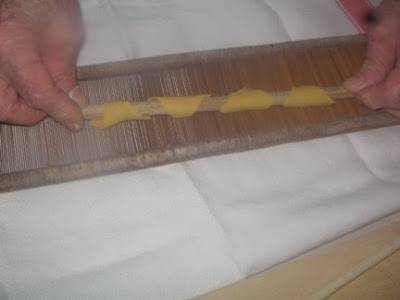Take it away, DoBianchi...
I cannot conceal that when Tracie B asked me to guest blog at My Life Italian, I was thrilled. I mean, after all, who wouldn't be honored to contribute to the blog of the woman who wrote a line I wish I wrote, about happy vines she saw in Ischia: If I were a vine, I would grow here. Her innate gifts as a writer, her humor, honesty, and honed palate, and — above all — her insights and perspective into the "garden of Europe" — the bel paease — the fair country are what made me fall for her in the first place. The title of her blog alone still makes me melt. Hey, Tracie B, you had me at hello… Or should I say, ciao?
One of the fun things about our relationship and our shared Italophilia is how she lived in Southern Italy, while I lived in the North. When we talk together in Italian, it's a veritable Tower of Babel: she, the belle from Orange, Texas speaks with a rich, musical Neapolitan accent, and I, from San Diego, speak with a nasaly, sharp Veneto accent!
When she posted the other day about the preference and tradition of "dried pasta," pastasciutta, in Southern Italy, she suggested that I write something about the fresh pasta that prevails in Emilia. So, I wrote to my friend Dindo in Bologna, and asked him to take some photographs of his mother making the fresh pasta that she makes nearly every day.
It's not that people in the North don't eat dried pasta. As a matter of fact, the Emilians are very proud of their Barilla, which is based in their region. But fresh lasagne and tagliatelle reign supreme there, as do a wide variety of stuffed fresh pastas — ravioli, tortelli, tortellini, cappelletti, etc.
Historically, dried pasta has its origins in Southern Italy. In Maestro Martino's 15th-century cookbook The Art of Cooking (which I translated for University of California Press, 2005), he includes a recipe for a dried pasta that resemble today's fusilli. He calls it "Sicilian macaroni" and instructs the reader to dry it in the sun, adding that it can last for up to three years. It's very likely that the warmer temperatures of the South and the ventilation provided by the sea are among the factors that would make Gragnano near Naples the unrivalled center for the production of dried pasta by the mid-18th century.
In landlocked Emilia, humidity and colder temperatures are factors in a unique macroclimate that gives us a variety of culinary wonders, like Parmigiano Reggiano. Did you know, for example, that you can replicate the methods for making Parmigiano Reggiano elsewhere in the world, but it only gets that unique texture and consistency when made in the foggy, damp provinces of Parma and Reggio Emilia (where the smell of pig poop is ubiquitous)?
There are other reasons why the Emilians still favor fresh pasta but the geography and climate alone are a big part of why fresh pasta prevails in the North.
Here is Signora Corradino's method for making garganelli, with ridges of course!

After you've rolled the pasta out, you cut it into squares.

Then you roll those around a wooden rod (this is similar to Maestro Martino's technique for Sicilian macaroni).

Then you make the ridges — so important in order for the sauce to penetrate the pasta — using a specially made pasta loom.
No comments:
Post a Comment